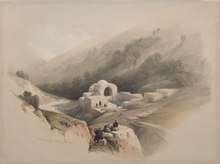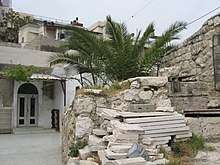Ein Rogel
Ein Rogel (Hebrew: עין רגל, Ein Rogel), or the Fountain of Job or Job's Well (translated from Arabic: بئر أيوب, Bir Ayoub), also known as Joab's Well, which better fits the Biblical context, was a spring on the outskirts of Jerusalem mentioned in the Hebrew Bible as the hiding-place of David's spies, Jonathan and Ahimaaz, during Absalom's uprising against the rule of King David (2 Samuel 17:17). It may also have been a sacred place in pre-Israelite times.[1] In English it also appears as Enrogel,[2] En-rogel [3] or En Rogel.[4]

The Bir Ayoub Mosque of Silwan stands above the well today.
Biblical accounts
_(28700151844).jpg)
En Rogel was one of the boundary marks between Judah and Benjamin (Joshua 15:7, 18:16).
During Absalom's uprising against David, Jonathan and Ahimaaz stayed at Ein Rogel, "for they dared not be seen coming into the city (Jerusalem); so a female servant would come and tell them, and they would go and tell King David". However, "a lad saw them, and told Absalom", and so they had to flee to Bahurim.[5]
Ein Rogel lay close to a stone, Zoheleth, where Adonijah held a sacrificial feast when he attempted to assert his claims to the throne (1 Kings 1:9). The obviously sacred character of the spring suggests that it is the same as the Dragon Well or Serpent Well of Nehemiah 2:13.[1]
Meaning and location

_%D7%91%D7%90%D7%A8_%D7%99%D7%95%D7%90%D7%91_%D7%9C%D7%9E%D7%A8%D7%92%D7%9C%D7%95%D7%AA_%D7%94%D7%A9%D7%99%D7%9C%D7%95%D7%97_%D7%91%D7%99%D7%A8%D7%95%D7%A9%D7%9C%D7%99%D7%9D.D826-058.jpg)
The meaning of the name and its identification are uncertain.[1] The interpretation 'Fuller's Well' does not bear the mark of antiquity. It is probable that, like Zoheleth, the original name had some sacred or mythic significance.[1]
Two identifications of the place have been suggested.
- (1) Virgin’s fountain (‘Ain Sitti Maryam), later ‘Ain Umm ed-Deraj, ‘the only real spring close to Jerusalem,' exactly opposite to which lies ez-Zehweleh, perhaps Zoheleth; and
- (2) Bir Ayub, also known as the Well of Nehemiah, at the junction of two valleys, Wadi er-Rababi and Kidron. However, Bir-Ayub is a well, not a spring, and lies too far from ez-Zehweleh, although it lies near a large stone in Siloam village called Zehwillat. As Bir Ayub is in full view of the city, it does not suit the context of 2 Sam. 17:17, and its antiquity is uncertain.
The chief points in favour of (1) (which Baed. identifies with Gihon spring) are its antiquity and the evidence of Josephus, who places the well in the royal gardens.[6] Other arguments are based upon the fact that in later times the well was used by fullers.[1]
Ein Rogel is mentioned in "Topography of Jerusalem", a document found in the Cairo Geniza, which describes how the water breaks through to the riverbed after a winter of plentiful rainfall.[7]
External links
References
